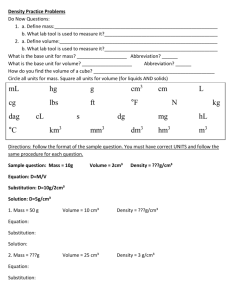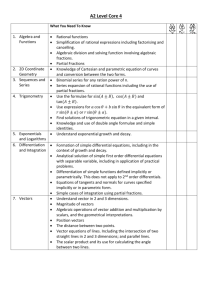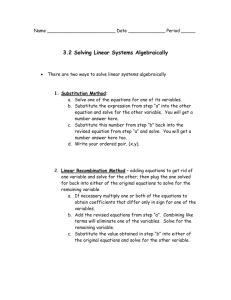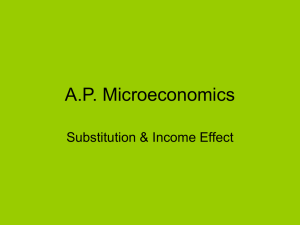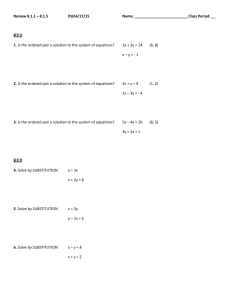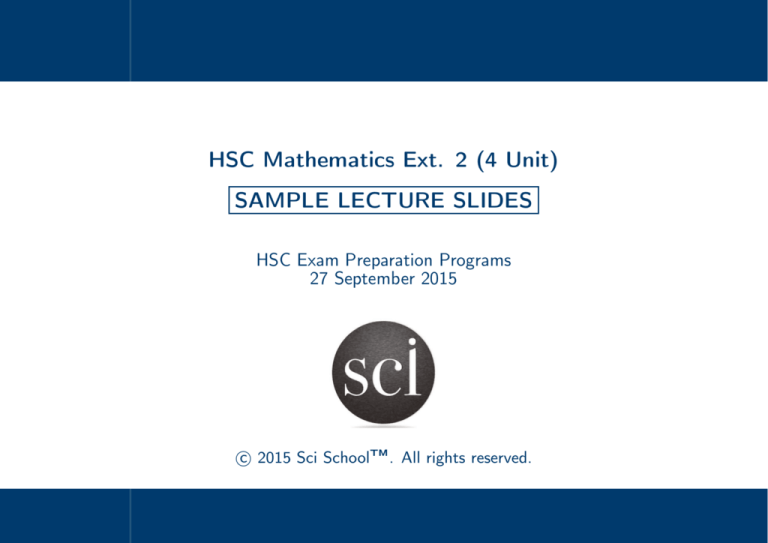
HSC Mathematics Ext. 2 (4 Unit)
SAMPLE LECTURE SLIDES
HSC Exam Preparation Programs
27 September 2015
c 2015 Sci SchoolTM . All rights reserved.
⃝
Overview
1. Graphs & Curve
Sketching
2. Conics
3. Polynomials
4. Complex Numbers
5. Complex Locus
Problems
6. Integration
7. Volumes
8. Mechanics
1. Graphs & Curve Sketching
2. Conics
3. Polynomials
4. Complex Numbers
5. Complex Locus Problems
6. Integration
7. Volumes
8. Mechanics
© 2015 Sci School
1. Graphs & Curve
Sketching
2. Conics
3. Polynomials
4. Complex Numbers
5. Complex Locus
Problems
6. Integration
6.1 Integration by
Substitution
6.2 Integration By
Parts
6.3 Recurrence
Relationships
6. Integration
6.4 Rational
Functions
6.5 Partial Fractions
6.6 t Formulae
Substitution
6.7 HSC-Adapted
Questions
6.7 HSC-Adapted
Questions
7. Volumes
8. Mechanics
© 2015 Sci School
6.1 Integration by Substitution
1. Graphs & Curve
Sketching
2. Conics
This technique is derived from the Fundamental Theorem of Calculus, which
states that, for continuous functions f (x) = F ′ (x) and u(x),
3. Polynomials
!
4. Complex Numbers
5. Complex Locus
Problems
6. Integration
6.1 Integration by
Substitution
6.2 Integration By
Parts
6.3 Recurrence
Relationships
6.4 Rational
Functions
6.5 Partial Fractions
6.6 t Formulae
Substitution
6.7 HSC-Adapted
Questions
6.7 HSC-Adapted
Questions
7. Volumes
8. Mechanics
b
a
′
(F (u)) dx = F (u(b)) − F (u(a))
=
!
u(b)
f (u) du.
u(a)
The Chain Rule tell us that
′
(F (u)) = f (u)u′ .
Hence, we arrive at the rule for Integration by Substitution:
!
a
b
g(x) dx =
!
u(b)
f (u) du, where g(x) = f (u)u′
u(a)
© 2015 Sci School
6.1 Integration by Substitution
1. Graphs & Curve
Sketching
The original integral (in x) is transformed to an equivalent integral in u.
2. Conics
3. Polynomials
x→u
4. Complex Numbers
5. Complex Locus
Problems
6. Integration
6.1 Integration by
Substitution
6.2 Integration By
Parts
6.3 Recurrence
Relationships
6.4 Rational
Functions
6.5 Partial Fractions
6.6 t Formulae
Substitution
6.7 HSC-Adapted
Questions
6.7 HSC-Adapted
Questions
7. Volumes
8. Mechanics
For example, solve
a
b
"1
√
−1
x
u(a)
u(b)
u
x 2x + 3 dx using the substitution u = 2x + 3.
• Step 1: Find an expression for u′ .
u = 2x + 3 =⇒ u′ = 2
• Step 2: Substitute every x with u in the integrand.
√
√
1
(u − 3) u
x 2x + 3 −→
2
© 2015 Sci School
6.1 Integration by Substitution
1. Graphs & Curve
Sketching
2. Conics
3. Polynomials
4. Complex Numbers
5. Complex Locus
Problems
6. Integration
6.1 Integration by
Substitution
6.2 Integration By
Parts
6.3 Recurrence
Relationships
6.4 Rational
Functions
6.5 Partial Fractions
6.6 t Formulae
Substitution
6.7 HSC-Adapted
Questions
6.7 HSC-Adapted
Questions
7. Volumes
8. Mechanics
• Step 3: Evaluate the transformed limits.
u(−1) = 2(−1) + 3 = 1 and u(1) = 2(1) + 3 = 5
• Step 4: Transform the integral and solve.
f (u)
u′
#
$%
& #$%&
√
√
1
1
(u − 3) u (2) dx
x 2x + 3 dx =
2
2
−1
−1
!
1
1 5
=
(u − 3)u 2 du
4 1
!
(
1
1 5' 3
=
u 2 − 3u 2 du
4 1
*5
)
3
1 2 52
u − 2u 2
=
4 5
1
2
=
5
!
1
!
1
© 2015 Sci School
6.2 Integration By Parts
1. Graphs & Curve
Sketching
2. Conics
3. Polynomials
4. Complex Numbers
5. Complex Locus
Problems
6. Integration
6.1 Integration by
Substitution
6.2 Integration By
Parts
6.3 Recurrence
Relationships
6.4 Rational
Functions
6.5 Partial Fractions
6.6 t Formulae
Substitution
6.7 HSC-Adapted
Questions
6.7 HSC-Adapted
Questions
7. Volumes
This method is best applied to integrals of products of functions. The
theorem is derived from the Product Rule,
! b
! b
b
uv ′ dx +
vu′ dx
(uv)′ = uv ′ + vu′ =⇒ [uv]a =
a
a
Rearranging, we arrive at the formula for Integration by Parts.
!
a
b
uv ′ dx =
[uv]ba
−
!
b
vu′ dx
a
To guide our choice for u and v ′ , we use the DETAIL Rule:
v Dashed should be tried in order of Exponentials, Trig functions,
Algebraic functions, Inverse trig functions, then Logarithms.
8. Mechanics
© 2015 Sci School
6.2 Integration by Parts
1. Graphs & Curve
Sketching
2. Conics
3. Polynomials
4. Complex Numbers
5. Complex Locus
Problems
6. Integration
6.1 Integration by
Substitution
6.2 Integration By
Parts
6.3 Recurrence
Relationships
6.4 Rational
Functions
6.5 Partial Fractions
6.6 t Formulae
Substitution
6.7 HSC-Adapted
Questions
6.7 HSC-Adapted
Questions
7. Volumes
8. Mechanics
For example, by integration by parts to evaluate
• Step 1: Identify v ′ and integrate to find v.
′
v = cos 3x
=⇒
"π
0
(1 − x) cos 3x dx.
1
v = sin 3x
3
• Step 2: Identify u and differentiate to find u′ .
u=1−x
=⇒
u′ = −1
• Step 3: Use the formula for integration by parts to rewrite the integral.
)
+
,*π ! π
! π
1
1
sin 3x
sin 3x(−1) dx
(1 − x) cos 3x dx = (1 − x)
−
3
3
0
0
0
! π
1
=0+
sin 3x dx
3 0
*π
)
1
2
1
=
− cos 3x =
3
3
9
0
© 2015 Sci School
6.3 Recurrence Relationships
1. Graphs & Curve
Sketching
2. Conics
3. Polynomials
Sometimes several applications of the Integration by Parts formula is needed
to evaluate an integral. This often yields recurring expressions, which can be
used to quickly get to the solution.
4. Complex Numbers
5. Complex Locus
Problems
6. Integration
6.1 Integration by
Substitution
6.2 Integration By
Parts
6.3 Recurrence
Relationships
6.4 Rational
Functions
6.5 Partial Fractions
6.6 t Formulae
Substitution
6.7 HSC-Adapted
Questions
6.7 HSC-Adapted
Questions
7. Volumes
8. Mechanics
For example, evaluate
"
e2x sin x dx.
v ′ = sin x =⇒ v = − cos x
u = e2x =⇒ u′ = 2e2x
Using one application of integration by parts,
!
!
- 2x .
2x
2x
dx
e sin x dx = e (− cos x) − (− cos x) 2e
!
= −e2x cos x + 2 e2x cos x dx
© 2015 Sci School
6.3 Recurrence Relationships
1. Graphs & Curve
Sketching
Applying integration by parts a second time,
2. Conics
3. Polynomials
4. Complex Numbers
5. Complex Locus
Problems
6. Integration
6.1 Integration by
Substitution
6.2 Integration By
Parts
6.3 Recurrence
Relationships
6.4 Rational
Functions
6.5 Partial Fractions
6.6 t Formulae
Substitution
6.7 HSC-Adapted
Questions
6.7 HSC-Adapted
Questions
7. Volumes
8. Mechanics
∴
!
v ′ = cos x =⇒ v = sin x
+
,
!
.
e2x sin x dx = −e2x cos x + 2 e2x sin x − sin x 2e2x dx
!
= −e2x cos x + 2e2x sin x − 4 e2x sin x dx
"
Noticing that e2x sin x dx is a recurrence of the original integral, we can
move it to the left-hand side.
!
5 e2x sin x dx = −e2x cos x + 2e2x sin x
!
e2x
2x
(2 sin x − cos x) + C
∴ e sin x dx =
5
© 2015 Sci School
6.3 Recurrence Relationships
1. Graphs & Curve
Sketching
2. Conics
3. Polynomials
4. Complex Numbers
5. Complex Locus
Problems
6. Integration
6.1 Integration by
Substitution
6.2 Integration By
Parts
6.3 Recurrence
Relationships
6.4 Rational
Functions
6.5 Partial Fractions
6.6 t Formulae
Substitution
6.7 HSC-Adapted
Questions
6.7 HSC-Adapted
Questions
7. Volumes
8. Mechanics
Another powerful example occurs when u takes the form of an algebraic (or
power) function, e.g. xn .
" n x
Consider applying integration by parts to In = x e dx.
v ′ = ex =⇒ v = ex and u = xn =⇒ u′ = nxn−1
!
!
∴ xn ex dx = xn ex − n xn−1 ex dx
Written with different notation, we have
For example,
"
In = xn ex − nIn−1
x4 ex dx can be evaluated using only algebra, since
I4 = x4 ex − 4I3
- 3 x
- 2 x
..
4 x
x
x
= x e − 4 x e − 3 x e − 2 (xe − e ) + C
- 4
.
x
3
2
= e x − 4x + 12x − 24x + 24 + C
© 2015 Sci School
6.4 Rational Functions
1. Graphs & Curve
Sketching
2. Conics
3. Polynomials
4. Complex Numbers
5. Complex Locus
Problems
6. Integration
6.1 Integration by
Substitution
6.2 Integration By
Parts
6.3 Recurrence
Relationships
6.4 Rational
Functions
6.5 Partial Fractions
6.6 t Formulae
Substitution
6.7 HSC-Adapted
Questions
6.7 HSC-Adapted
Questions
7. Volumes
8. Mechanics
When our integral involves the quotient of two functions, we can use the
following approaches:
• Technique 1: Polynomial division, then integration term-by-term.
• Technique 2: Algebraic rearrangement to the form
!
f ′ (x)
dx, then
f (x)
!
1
dx, then
2
2
x +a
f ′ (x)
dx = ln |f (x)| + C
f (x)
• Technique 3: Algebraic rearrangement to the form
!
!
'x(
1
1
−1
dx
=
tan
+C
x2 + a 2
a
a
© 2015 Sci School
6.4 Rational Functions
1. Graphs & Curve
Sketching
For example, use Techniques 2 and 3 to evaluate
2. Conics
3. Polynomials
4. Complex Numbers
5. Complex Locus
Problems
6. Integration
6.1 Integration by
Substitution
6.2 Integration By
Parts
6.3 Recurrence
Relationships
6.4 Rational
Functions
6.5 Partial Fractions
6.6 t Formulae
Substitution
6.7 HSC-Adapted
Questions
6.7 HSC-Adapted
Questions
!
f ′ (x)
"
2x−3
x2 −4x+5
dx.
# $% &
2x − 4 +1
2x − 3
dx
=
dx
2
2
x − 4x + 5
x − 4x + 5
!
!
2x − 4
1
dx
+
dx
=
2
2
x − 4x + 5
x − 4x + 5
!
1
= log |x2 − 4x + 5| +
dx
2
x − 4x + 4 + 1
!
1
dx
= log |x2 − 4x + 5| +
2
(x − 2) + 1
!
= log |x2 − 4x + 5| + tan−1 (x − 1) + C
7. Volumes
8. Mechanics
© 2015 Sci School
6.5 Partial Fractions
1. Graphs & Curve
Sketching
2. Conics
3. Polynomials
4. Complex Numbers
5. Complex Locus
Problems
6. Integration
6.1 Integration by
Substitution
6.2 Integration By
Parts
6.3 Recurrence
Relationships
6.4 Rational
Functions
6.5 Partial Fractions
6.6 t Formulae
Substitution
6.7 HSC-Adapted
Questions
6.7 HSC-Adapted
Questions
7. Volumes
8. Mechanics
Partial fractions is an"extension of the previous techniques, applied to
P (x)
integrals of the form Q(x)R(x)
dx.
The fraction is expanded into simpler (partial) fractions, which are then
integrated term-by-term.
!
P (x)
dx =
Q(x)R(x)
!
A(x)
dx +
Q(x)
!
B(x)
dx
R(x)
For example, use the method of partial fractions to evaluate
• Step 1: Factorise the denominator.
"
2x−1
x2 −5x+6
dx.
2x − 1
2x − 1
=
x2 − 5x + 6
(x − 2)(x − 3)
© 2015 Sci School
6.4 Partial Fractions
1. Graphs & Curve
Sketching
2. Conics
3. Polynomials
4. Complex Numbers
5. Complex Locus
Problems
6. Integration
6.1 Integration by
Substitution
6.2 Integration By
Parts
6.3 Recurrence
Relationships
6.4 Rational
Functions
6.5 Partial Fractions
6.6 t Formulae
Substitution
6.7 HSC-Adapted
Questions
6.7 HSC-Adapted
Questions
7. Volumes
8. Mechanics
• Step 2: Split into partial fractions.
2x − 1
A
B
=
+
(x − 2)(x − 3)
(x − 2) (x − 3)
=⇒ 2x − 1 = A(x − 3) + B(x − 2)
• Step 3: Substitute well-chosen values of x to find A and B.
x = 2 : 2(2) − 1 = A(2 − 3) + 0
∴ A = −3
x = 3 : 2(3) − 1 = 0 + B(3 − 2)
∴ B=5
• Step 4: Integrate term-by-term.
,
! +
!
3
5
2x − 1
dx =
−
+
dx
(x − 2)(x − 3)
x−2 x−3
= −3 ln |x − 2| + 5 ln |x − 3| + C
© 2015 Sci School
6.6 t Formulae Substitution
1. Graphs & Curve
Sketching
2. Conics
A special category of Integration by Substitution is to use t = tan
solve integrals of the form,
3. Polynomials
!
4. Complex Numbers
5. Complex Locus
Problems
6. Integration
6.1 Integration by
Substitution
6.2 Integration By
Parts
6.3 Recurrence
Relationships
6.4 Rational
Functions
6.5 Partial Fractions
6.6 t Formulae
Substitution
6.7 HSC-Adapted
Questions
6.7 HSC-Adapted
Questions
7. Volumes
8. Mechanics
Defining t = tan
-x.
2
-x.
2
to
1
dx
a cos x + b sin x + c
, our essential substitution formulae are:
2 dt
1 + t2
sin x =
2t
1 + t2
1 − t2
cos x =
1 + t2
tan x =
2t
1 − t2
dx =
© 2015 Sci School
6.6 t Formulae Substitution
1. Graphs & Curve
Sketching
The first formula is derived using calculus as follows.
2. Conics
3. Polynomials
4. Complex Numbers
5. Complex Locus
Problems
6. Integration
6.1 Integration by
Substitution
6.2 Integration By
Parts
6.3 Recurrence
Relationships
6.4 Rational
Functions
6.5 Partial Fractions
6.6 t Formulae
Substitution
6.7 HSC-Adapted
Questions
6.7 HSC-Adapted
Questions
7. Volumes
8. Mechanics
' x ((
dt
d '
=
tan
dx
dx
2
'
(
1
2 x
= sec
2
2
'
'x(
(
1
tan2
+1
=
2
2
.
1-2
=
t +1
2
Separating the variables, we arrive at
.
1-2
t + 1 dx
dt =
2
or
dx =
2 dt
1 + t2
© 2015 Sci School
6.6 t Formulae Substitution
1. Graphs & Curve
Sketching
2. Conics
3. Polynomials
4. Complex Numbers
5. Complex Locus
Problems
The remaining formulae are derived using geometry & double-angle identities.
Consider a right-angled triangle consistent with t = tan θ2 . With respect to
the angle θ2 , the ratio of opposite & adjacent sides is t : 1. Hence, by
√
Pythagorus’ Theorem, the hypotenuse is 1 + t2 .
6. Integration
6.1 Integration by
Substitution
6.2 Integration By
Parts
6.3 Recurrence
Relationships
6.4 Rational
Functions
6.5 Partial Fractions
6.6 t Formulae
Substitution
6.7 HSC-Adapted
Questions
6.7 HSC-Adapted
Questions
7. Volumes
8. Mechanics
√
t
1 + t2
θ
2
1
Using double-angle identities, we can express
sin θ in terms of t,
+ ,
+ ,
θ
θ
sin θ = 2 sin
cos
2
2
1
t
·√
=2· √
1 + t2
1 + t2
2t
=
1 + t2
© 2015 Sci School
6.6 t Formulae Substitution
1. Graphs & Curve
Sketching
2. Conics
3. Polynomials
4. Complex Numbers
5. Complex Locus
Problems
6. Integration
6.1 Integration by
Substitution
6.2 Integration By
Parts
6.3 Recurrence
Relationships
6.4 Rational
Functions
6.5 Partial Fractions
6.6 t Formulae
Substitution
6.7 HSC-Adapted
Questions
6.7 HSC-Adapted
Questions
7. Volumes
8. Mechanics
Likewise for cos θ and tan θ,
+ ,
+ ,
θ
θ
2
2
− sin
cos θ = cos
2
2
1
t2
=
−
1 + t2
1 + t2
1 − t2
=
1 + t2
sin θ
cos θ
1 + t2
2t
×
=
2
1+t
1 − t2
2t
=
1 − t2
tan θ =
© 2015 Sci School
6.6 t Formulae Substitution
1. Graphs & Curve
Sketching
2. Conics
The t-formulae are used by substituting all expressions in x, e.g. dx, sin x,
cos x, and tan x, for corresponding expressions in t.
3. Polynomials
4. Complex Numbers
5. Complex Locus
Problems
6. Integration
6.1 Integration by
Substitution
6.2 Integration By
Parts
6.3 Recurrence
Relationships
6.4 Rational
Functions
6.5 Partial Fractions
6.6 t Formulae
Substitution
6.7 HSC-Adapted
Questions
6.7 HSC-Adapted
Questions
7. Volumes
8. Mechanics
For example,
!
1
dx =
3 + 2 cos x
!
3+2
!
1
'
(·
2
1−t
1+t2
2 dt
t2 + 1
1
dt
=2
3(1 + t2 ) + 2(1 − t2 )
!
1
=2
dt
2
5+t
+
+
,
,
1
t
=2 √
tan−1 √
+C
5
5
+
' x (,
1
2
+C
= √ tan−1 √ tan
2
5
5
© 2015 Sci School
6.7 HSC-Adapted Questions
1. Graphs & Curve
Sketching
Question 1 (3 Marks)
2. Conics
Evaluate
3. Polynomials
!
4. Complex Numbers
5. Complex Locus
Problems
6. Integration
6.1 Integration by
Substitution
6.2 Integration By
Parts
6.3 Recurrence
Relationships
6.4 Rational
Functions
6.5 Partial Fractions
6.6 t Formulae
Substitution
6.7 HSC-Adapted
Questions
6.7 HSC-Adapted
Questions
7. Volumes
8. Mechanics
e2
2
dx.
x ln x
e
Solution
Rewrite the integral in the form of
!
e
e2
"
2
dx = 2
x ln x
=
f ′ (x)
f (x)
!
e
e2
dx.
1
x
ln x
dx
e2
2 [ln |ln x|]e
- / 2/
/
/
.
= 2 ln ln e − ln |ln e|
= 2 (ln 2 − ln 1)
= 2 ln 2
© 2015 Sci School
6.7 HSC-Adapted Questions
1. Graphs & Curve
Sketching
Question 2 (4 Marks)
2. Conics
Solve
3. Polynomials
!
2
4. Complex Numbers
4
x2
dx.
2
12 + 9x
5. Complex Locus
Problems
Solution
6. Integration
1
Rewrite the integral in the form of x2 +a
2 dx.
! 4 2
! 4
2
x
1
9x + 12 − 12
dx
=
dx
2
2
9 2
12 + 9x
2 12 + 9x
+
,
! 4
4
1
1−
dx
=
2
9 2
4 + 3x
0
1 √ 234
1
2
3x
x − √ tan−1
=
9
2
3
2
(
(
'
'
√
√
√
2
=
1 − 3 3 tan−1 2 3 + 3π
81
6.1 Integration by
Substitution
6.2 Integration By
Parts
6.3 Recurrence
Relationships
6.4 Rational
Functions
6.5 Partial Fractions
6.6 t Formulae
Substitution
6.7 HSC-Adapted
Questions
6.7 HSC-Adapted
Questions
7. Volumes
8. Mechanics
"
© 2015 Sci School
6.7 HSC-Adapted Questions
1. Graphs & Curve
Sketching
Question 3 (4 Marks)
2. Conics
Evaluate
3. Polynomials
4. Complex Numbers
5. Complex Locus
Problems
!
√
3
3
1
x2
√
1
dx.
2
x +1
6. Integration
6.1 Integration by
Substitution
6.2 Integration By
Parts
6.3 Recurrence
Relationships
6.4 Rational
Functions
6.5 Partial Fractions
6.6 t Formulae
Substitution
6.7 HSC-Adapted
Questions
6.7 HSC-Adapted
Questions
7. Volumes
8. Mechanics
Solution
Use integration by substitution, with x = tan u.
dx
= sec2 u
du
∴ dx = sec2 u du
Substitute every x with u in the integrand.
1
1
1
√ 2
√
−→
=
2
2
2
tan2 u sec u
x x +1
tan u tan u + 1
© 2015 Sci School
6.7 HSC-Adapted Questions
1. Graphs & Curve
Sketching
−1
When x = 1, u = tan
(1) =
π
4.
When x =
√
3
3 ,
2. Conics
3. Polynomials
4. Complex Numbers
5. Complex Locus
Problems
6. Integration
6.1 Integration by
Substitution
6.2 Integration By
Parts
6.3 Recurrence
Relationships
6.4 Rational
Functions
6.5 Partial Fractions
6.6 t Formulae
Substitution
6.7 HSC-Adapted
Questions
6.7 HSC-Adapted
Questions
7. Volumes
8. Mechanics
u = tan−1 ( √13 ) =
π
6.
Transforming the integral, we have
!
1
√
3
3
1
√
dx =
2
2
x x +1
!
!
π
6
π
4
1
2
·
sec
u du
tan2 u sec u
π
6
cos u
du
2
π
sin u
4
4
5π
−1 6
= (− sin u)
π
=
4
=−
sin
1
-π. +
6
√
= 2−2
sin
1
-π.
4
© 2015 Sci School
6.7 HSC-Adapted Questions
1. Graphs & Curve
Sketching
Question 4 (5 Marks)
2. Conics
Using the substitution t = tan x2 , or otherwise, show that
6√
2π
! 3
1
3
dx = loge
.
π
sin x + tan x
e
2
3. Polynomials
4. Complex Numbers
5. Complex Locus
Problems
6. Integration
6.1 Integration by
Substitution
6.2 Integration By
Parts
6.3 Recurrence
Relationships
6.4 Rational
Functions
6.5 Partial Fractions
6.6 t Formulae
Substitution
6.7 HSC-Adapted
Questions
6.7 HSC-Adapted
Questions
7. Volumes
8. Mechanics
Solution
We need the following three t formulae:
dx =
Also, when x =
2 dt
2t
2t
,
sin
x
=
,
and
tan
x
=
.
2
2
2
1+t
1+t
1−t
π
2,
t = tan
π
4
= 1. When x =
2π
3 ,
t = tan
π
3
√
= 3.
© 2015 Sci School
6.7 HSC-Adapted Questions
1. Graphs & Curve
Sketching
2. Conics
3. Polynomials
4. Complex Numbers
5. Complex Locus
Problems
6. Integration
6.1 Integration by
Substitution
6.2 Integration By
Parts
6.3 Recurrence
Relationships
6.4 Rational
Functions
6.5 Partial Fractions
6.6 t Formulae
Substitution
6.7 HSC-Adapted
Questions
6.7 HSC-Adapted
Questions
7. Volumes
8. Mechanics
!
2π
3
π
2
1
dx =
sin x + tan x
!
√
3
1
!
√
3
2t
1+t2
1
+
2t
1−t2
2 dt
·
1 + t2
(1 + t2 )(1 − t2 )
2 dt
=
·
2t − 2t3 + +2t + 2t3 1 + t2
1
,
! √3 +
2
1
t
−
=2
dt
4t 4t
1
*√3
)
1
1
=
ln |t| − t2
2
2 1
(
1' √
ln 3 − 1
=
2
(
1' √
ln 3 − ln e
=
2
1 √ 2 12
3
= ln
, as required.
e
© 2015 Sci School
6.7 HSC-Adapted Questions
1. Graphs & Curve
Sketching
Question 5 (7 Marks)
2. Conics
Let
3. Polynomials
Ik =
4. Complex Numbers
5. Complex Locus
Problems
6. Integration
6.1 Integration by
Substitution
6.2 Integration By
Parts
6.3 Recurrence
Relationships
6.4 Rational
Functions
6.5 Partial Fractions
6.6 t Formulae
Substitution
6.7 HSC-Adapted
Questions
6.7 HSC-Adapted
Questions
7. Volumes
8. Mechanics
where k is an integer, k ≥ 0.
!
π
cos2k+1 x dx,
0
(i) Show that
Ik = −π + (2k + 1)
for k ≥ 1. (3 Marks)
(ii) Show also that
Ik =
for k ≥ 1. (3 Marks)
!
π
x sin x cos2k x dx
0
2k
Ik−1
2k − 1
(ii) Explain why Ik = 0 for k ≥ 1. (1 Mark)
© 2015 Sci School
6.7 HSC-Adapted Questions
1. Graphs & Curve
Sketching
Solution
2. Conics
(i) Using integration by parts, we have
3. Polynomials
4. Complex Numbers
5. Complex Locus
Problems
6. Integration
6.1 Integration by
Substitution
6.2 Integration By
Parts
6.3 Recurrence
Relationships
6.4 Rational
Functions
6.5 Partial Fractions
6.6 t Formulae
Substitution
6.7 HSC-Adapted
Questions
6.7 HSC-Adapted
Questions
7. Volumes
8. Mechanics
v ′ = 1 =⇒ v = x
u = cos2k+1 x =⇒ u′ = (2k + 1) cos2k x(− sin x)
Substituting these values into the integration by parts formula,
! π
7
8
π
Ik = x cos2k+1 x 0 −
x(2k + 1) cos2k x(− sin x) dx
0
! π
= π · (−1)2k+1 + (2k + 1)
x sin x cos2k x dx
0
! π
x sin x cos2k x dx,
= −π + (2k + 1)
0
since 2k + 1 is odd for all integers k ≥ 0.
© 2015 Sci School
6.7 HSC-Adapted Questions
1. Graphs & Curve
Sketching
2. Conics
3. Polynomials
4. Complex Numbers
5. Complex Locus
Problems
6. Integration
6.1 Integration by
Substitution
6.2 Integration By
Parts
6.3 Recurrence
Relationships
6.4 Rational
Functions
6.5 Partial Fractions
6.6 t Formulae
Substitution
6.7 HSC-Adapted
Questions
6.7 HSC-Adapted
Questions
7. Volumes
8. Mechanics
(ii) Rewrite the integral as
"π
0
cos2k x cos x dx and use integration by parts.
v ′ = cos x =⇒ v = − sin x
u = cos2k x =⇒ u′ = 2k cos2k−1 x(− sin x)
! π
=⇒ Ik =
cos2k x cos x dx
0
! π
8
7
π
(− sin x)2k cos2k−1 x(− sin x) dx
= − cos2k x sin x 0 −
0
! π
= −2k
cos2k−1 x(1 − cos2 x) dx
0
= −2kIk−1 + 2kIk
∴ (1 − 2k)Ik = −2kIk−1
2k
Ik−1 , as required.
Ik =
2k − 1
© 2015 Sci School
6.7 HSC-Adapted Questions
1. Graphs & Curve
Sketching
(iii) Using Part (ii), we have
2. Conics
3. Polynomials
4. Complex Numbers
5. Complex Locus
Problems
6. Integration
6.1 Integration by
Substitution
6.2 Integration By
Parts
6.3 Recurrence
Relationships
6.4 Rational
Functions
6.5 Partial Fractions
6.6 t Formulae
Substitution
6.7 HSC-Adapted
Questions
6.7 HSC-Adapted
Questions
7. Volumes
8. Mechanics
for k ≥ 1.
2k
Ik−1
Ik =
2k − 1
Substituting k = 1 gives us,
2
I0
I1 =
2−1
! π
=
cos x dx
0
= 0.
Since Ik is a multiple of Ik−1 for all integers k ≥ 1, Ik is a multiple of zero.
Hence, Ik = 0 for all integers k ≥ 1.
© 2015 Sci School


